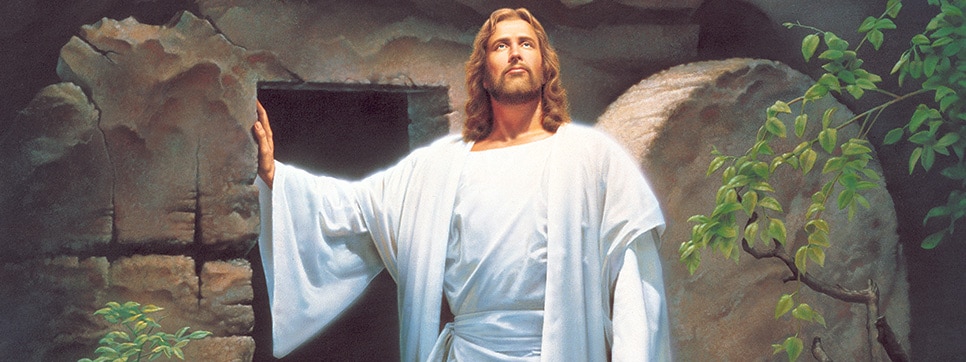I taught a lesson on the Resurrection last Sunday to two different classes. In both classes we had a mock trial- calling eye witnesses to the stand- to prove that the Resurrection of Jesus Christ actually happened. The lesson to the 12&13 year old boys and girls was a flop, but the lesson to the 14&15 year old girls was a spiritual success.
I’m not exactly sure why one lesson went so wrong and one went so well, but regardless, I think the format of this lesson came to me through inspiration.
My friend borrowed it for extended family home evening and said, “It went awesome. It was a spiritual experience.” So it can work great for adults too.
This lesson does require significant study on the teacher’s part because he/she is acting as the prosecutor. Here is the outline:

The Resurrection on Trial
Materials:
- Judge’s robe (I used a dracula cape from my Halloween box)
- Gavel (I used the knee knocker from my kid’s plastic medical kit)
- Police badge for the bailiff (I actually had one in my props box; you could make one out of paper)
- Scriptures for each witness
Characters:
- Judge
- Bailiff
- Prosecutor- (should be the teacher)
- Eye Witnesses-
- Mary Magdalene, additional woman, two disciples on the road to Emmaus, any of the 11 apostles, Thomas, 1 of 500, James, Nephites…
- Assign scripture passages to each witness. You can use as many or as little eyewitness as you have to work with.
- Give them time to study their scriptures and be prepared to answer their questions. Ahead of time is even better. If I were to do this again, I would also provide the questions that they would be required to answer. That would make the witness stand experience a bit smoother.
Here is a list of witnesses and scripture references:
Mary Magdalene (John 20; Mark 16:9-10)
Other Woman (Matthew 28: 1-10) She is significant because she actually touched His feet.
**The fact that WOMEN are the first to see Christ is significant. If the apostles were to steal a body and fabricate a story it is unlikely that they would have put women as their first witnesses. Women were not respected in that day, and it would have been a risk to their plot.**
Two disciples on the road to Emmaus (Luke 24:13-32) I just called up one of the disciples.
1 of 500 brethern (1 Corinthians 15:6) This is significant because there is no way 500 people could have hallucinated the same personage. A group sighting has more value than an individual.
1 of the 11 Apostles (Mark 16:14, John 20;18-21; John 21)
Thomas (John 20:26-29)
Any Nephite (3 Nephi 11; 3 Nephi 17:21-25) This is significant because He is in another continent, but He also interacted with them, taught them, blessed them. etc. They got to touch his hands and feet too.
——-
Script:
Bailiff: “The Jerusalem District Court is now in session. The Honorable Judge ______ is presiding. Please arise. (Judge walks in.) You may be seated.”
Judge: “The court calls case number 1505. (To the prosecutor) Do you have an opening statement?”
Prosecutor: “Yes, your honor.”
Judge: “Please proceed.”
Prosecutor: Give opening statement. This is where you tell them what you are going to tell them. Something along the lines of “I am going to prove that Jesus Christ was in actuality resurrected. That He was dead and is now alive. We know that the tomb was empty, no body has ever been found, and several eye witnesses can testify that they saw him in the flesh….”
Judge: “Please call your first witness.”
Prosecutor: “Your honor, I call Mary Magdalene to the stand.”
(First witness comes to the stand)
The Bailiff can do the whole “swear to tell the whole truth and nothing but the truth” thing. One class wanted to; the other didn’t. We didn’t swear on a real Bible though as we didn’t want to be disrespectful, so we just used another book.
Ask Mary questions like:
“Please state your name for the court.”
“Where were you on the 3rd day after Christ had been killed?”
“Why were you at the tomb that morning?”
“What did you find when you went to the tomb?”
“How did you finally know it was Jesus Christ whom you were talking to?”
“Did you actually touch Jesus Christ?”
etc. etc. Basically lead her to tell her whole story. Witnesses can use their scriptures while on the stand.
Continue this process with each witness tailoring the questions to their particular experience.
The most powerful part of the lesson was when I let every witness bear his/her testimony of what they saw, or I would say, “Is it your testimony that Jesus Christ lives?” or “Is it your testimony that Jesus Christ has risen?”
After all witnesses have been called and questioned
Prosecutor: “Your honor, I rest my case.”
Judge: “Do you have closing arguments?”
Prosecutor: “Yes, your honor.”
Judge: “Please proceed.”
Prosecutor: This is where you bear your testimony of the resurrection. Summarize some of what you proved, but share your own personal witness.
I then, per Come, Follow Me, issued a challenge to the kids. I asked them if they could stand as a personal witness of the Resurrection- not as Mary Magdalene or Thomas, but as a witness themselves? Do they truly believe that the Resurrection really happened? If they did, I invited them to stand as a witness to the Resurrection either in testimony meeting, to a friend, or in their journal, etc. I invited them to bear their own witness.
_____
My son was in the first class and my daughter was in the second. My goal with this lesson was to help strengthen their testimony of the Resurrection of Jesus Christ because everything we believe either stands or falls on the reality of the Resurrection. If we can be sure in this doctrine than we can be sure of so much more.
I know He lives!

![I spoke in church today and said the Atonement of Jesus Christ is the greatest act of Charity. I read Moroni 7:45-47 to make my point. But wherever there was the word ‘Charity’ I substituted it out for ‘the Atonement of Jesus Christ.’ See if these scripture verses now have new meaning for you:
“And the Atonement of Jesus Christ suffererth long, and is kind, and envieth not, and is not puffed up, seeketh not her own, is not easily provoked, thinketh no evil, and rejoiceth in the truth,
[The Atonement of Jesus Christ] beareth all things, believeth all things, hopeth all things, endureth all things.
Wherefore, my beloved brethren, if ye have not the Atonement of Jesus Christ, ye are nothing, for the Atonement of Jesus Christ never faileth. Wherefore, cleave unto the Atonement of Jesus Christ, which is the greatest of all, for all things must fail-
But the Atonement of Jesus Christ is the pure love of Christ, and it endureth forever; and whoso is found possessed of it at the last day, it shall be well with him.”
So Easter really reminds us of love. The first and greatest commandment.](https://www.raisinglemons.com/wp-content/plugins/instagram-feed-pro/img/placeholder.png)
Awesome idea!
I love the way you formatted this lesson—focusing on the principle of witnesses, but with a fresh take. Also, anything that helps kids feel the scriptures are more real is a good thing!